| Ipswich Blackfriars | |
|---|---|
| Saint Mary, Blackfriars, Ipswich | |
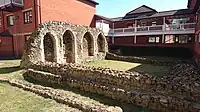 Remains of St Mary, Blackfriars, Ipswich | |
.svg.png.webp) Ipswich Blackfriars Location in Suffolk | |
| 52°03′18″N 1°09′30″E / 52.0550°N 1.1584°E | |
| Location | Ipswich, Suffolk |
| Country | England |
| Denomination | Roman Catholic |
| History | |
| Founded | 1263 |
| Dedication | Saint Mary |
| Architecture | |
| Closed | 1538 |
Ipswich Blackfriars was a medieval religious house of Friars-preachers (Dominicans) in the town of Ipswich, Suffolk, England, founded in 1263 by King Henry III and dissolved in 1538.[1] It was the second of the three friaries established in the town, the first (before 1236) being the Greyfriars, a house of Franciscan Friars Minors, and the third the Ipswich Whitefriars of c. 1278–79. The Blackfriars were under the Visitation of Cambridge.
The Blackfriars church, which was dedicated to St Mary, disappeared within a century after the Dissolution, but the layout of the other conventual buildings, including some of the original structures, survived long enough to be illustrated and planned by Joshua Kirby in 1748.[2] By that time later uses had supervened and their interpretation had become confused.[3] The last of the monastery buildings, the former sacristy, chapter house and dormitory, continued in use as a schoolroom for the Ipswich School until 1842 before finally being demolished in 1849. In 1898 Nina Layard had some success in locating buried footings.[4] A modern understanding of the site emerged during the 1970s and 1980s, through scholarly interpretation and in excavations by the Suffolk County Council team,[5] by which the position of the lost Blackfriars church was recognized and revealed, much of the original plan was clarified or confirmed, and former misapprehensions were corrected.[6][7]
The site of the Blackfriars church, between Foundation Street and Lower Orwell Street, is preserved as an open grassed recreation area where the footings of the building and a surviving fragment of the wall of the sacristy can be seen, and are explained by interpretative panels. A modern housing development covers the site of the lost conventual buildings.
Foundation
Contrary to earlier antiquarian tradition, in 1887 it was shown decisively[8] that King Henry III established the Dominican friars at Ipswich in 1263. Henry purchased land in Ipswich from Hugh son of Gerard de Langeston and gave it to the friars for them to live there, instructing John de Vallibus (de Vaux), Keeper of the Peace, to go in person to give them seisin.[9] On 26 November 1265 he augmented this grant with other land purchased from the same Hugh.[10] In the same founding phase Robert Kilwardby, who was appointed Provincial prior of the Dominicans in England in 1261 and became Archbishop of Canterbury in 1272, acquired a messuage on behalf of the friars in 1269.[11]
In April 1277 when visiting Ipswich Edward I gave the friars alms for food, and at Michaelmas term 1291 Queen Eleanor's executors gave 100 shillings to the friars preachers of Ipswich, and to 19 other houses.[12] In December 1296 and January following, when in Ipswich for the betrothal of his daughter Elizabeth to the Count of Holland, the King again gave alms.[13]
The old foundation attribution to "Henry de Manesby, Henry Redred and Henry de Landham", or else to "John Hares", arose from the monastic catalogue of John Speed, who in 1614 drew a distinction between a house of Friars Preachers in Ipswich (founded by the three), and the Ipswich Blackfriars (where John Hares "gave ground to build their house larger").[14] John Weever, 1631, followed Speed's first edition, listing burials for the former and "personages I finde to have beene registred in the Martirologe of this house" (probably benefactors) for the latter.[15] Later authorities saw the distinction was false,[16] and in reality all these supposed founders were later benefactors of the Dominican friars preachers.
Development
Among the names of principal benefactors, which Weever derived from the friars' calendar or martyrology, stood notably Roger Bigod, Earl Marshal, probably referring to the 5th Earl of Norfolk (died 1306). That of Sir Robert de Ufford, Earl of Suffolk (1298–1369), calls to mind the Ufford burials and the Despencer associations at the Ipswich Greyfriars. Sir Richard and Lady Margaret Plays (de Playz, or de Plais) were possibly that 4th Baron de Plaiz (c.1323-1360) of Chelsworth, Suffolk (heir to John de Lancastria)[17] and his wife Margaret, of Weeting Castle in Norfolk, of the founding family of Bromehill Priory of Austin canons,[18] where Sir John de Sutton (another Blackfriars benefactor) succeeded Sir Richard de Playz as patron of the parish advowson.[19] Their granddaughter Margaret married that Sir John Howard[20] who is also named among the benefactors of Blackfriars by Taylor.[21] These were patrons of the late 14th century.
Weever mentions the burial of Adam de Brandeston at Blackfriars, who was sometime M.P. and deputy butler of Ipswich,[22] but was outlawed for felony.[23] His will requesting burial at the friars preachers was proved in December 1362.[24] Gilbert Boulge ("Roulge"), an Ipswich wool merchant buried here, held a fourth part of a knight's fee in Debach in 1380.[25]
Excavation in the friary cemetery revealed about 250 burials,[26] including a man's skeleton from which the right hand had been severed, the wound having healed in his lifetime. The form of the injury indicated violent assault rather than a surgical or judicial amputation, and the victim had sustained other fractures. The unusual pathology suggested identification with Richard de Holebrok, of Tattingstone near Ipswich: in 1327 Richard was attacked at Tattingstone by a large mob led by Benedict, John and William de Braham, who tied him to a tree and cut off his hand.[27][28] Dame Alice de Holebrok, widow of Sir John, was among the burials observed by Weever at the Ipswich Greyfriars, and should be of this Tattingstone family.[29] Later a Holebrok married a Fastolf: John and Agnes Fastolf, who had tombs at Blackfriars, were probably among the Holebrok descendants who succeeded to their manors at Bentley and Holbrook.[30]
In around 1389 or 1391 it is recorded that a Provincial chapter was celebrated at Ipswich Blackfriars (probably one of many). Not long afterwards a disagreement arose as to who was the rightful prior. In 1397 the Master-general declared in favour of F. John de Stanton (and against F. William), at the same time assigning F. John Sygar as lector, and making other arrangements.[31]
The site
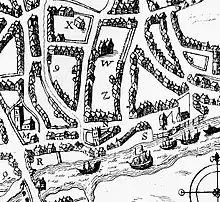
The Ipswich town rampart, reconstructed c.1200 on the line of a Viking-age defence,[32] lay in its south-eastern quarter on the east side of the Blackfriars site within the line of Lower Orwell Street. The friary lands accrued within this sector, with Foundation Street on its west side, and St Mary at Key to the south, within which parish it principally lay.[33] In 1307 Alice Harneis (wife of the leading townsman and coroner Philip Harneis, who led the group for the re-writing of the Town Custumal,[34] and to whom the town Farm was committed[35]), assigned to the friars a plot of 200 ft by 36 ft which she held from Sir Payn de Tibetot, 1st Baron Tibetot (c. 1279–1314),[36] (of the patron family of the Greyfriars[37]).[38] This required a Borough inquisition as it affected a Custom (Hadgavol) reserved to the Crown.[39]
An acre of land on the south side was assigned to the friars in 1334. The pardon granted to the friars in 1346 for 100 feet of land and a ditch acquired without licence from John Harneis (i.e. "John Hares") followed an inquisition stipulating that the townsmen were to have free ingress for maintaining and defending the rampart.[40] The donor was probably Philip's brother John, also prominent in town affairs, whose will was proved in 1323.[41] Similarly a grant made by the whole borough and commonalty in 1349, of a 103 ft plot extending into the middle of the town ditch, carried the proviso that the friars were to maintain the wall (rampart), and also the two great gates to north and south of their court by which the commonalty could have access if necessary. In 1352 three messuages (also yielding Hadgavol) were assigned for enlarging the homestead by Henry de Monessele, Henry Rodbert and Henry Loudham[42] (i.e. "Manesby, Redred and Landham").
The friary complex
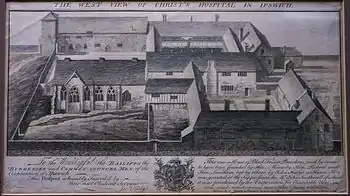
Joshua Kirby's 1748 Prospect and Plan of the buildings on the Blackfriars site preserved an important record, but sustained the misapprehension that a medieval structure with tracery windows (left, middle distance, aligned north–south) was the original friary church, that the large hall behind it (upper left) had been the friars' refectory, and that the two-tier galleried courtyard shown to the back right (a post-medieval construction, the Christ's Hospital) stood on the site of the friars' cloister.[43] In a study made in 1976 based upon contemporary understanding of English medieval friary construction, R. Gilyard-Beer observed that the supposed church was in fact the refectory or frater of the former Blackfriars, that the hall shown behind it had contained the sacristy, chapter house and dormitory, and that the courtyard between them was the true site of the friars' cloister.[44]

From this it was inferred that the real Blackfriars church had stood directly to the north of these, aligned east and west, its long aisled nave of some 135 ft length and 55 ft breadth forming the north side of the cloister, and the angle at the entry to the choir and sanctuary nesting against the north-west corner of the sacristy. The walking-place for the friars (entering from the cloister passage and crossing the church behind the altar) would have been within the nave structure at its east end, rather than within the choir structure at its west, the more usual arrangement.[45] These deductions were amply confirmed by excavations, which revealed the footprint (now preserved) of a very substantial aisled church extending fully as predicted from the (western) Foundation Street frontage to the unaisled choir (58 ft) ending close to the former rampart in the east, and with the walking-place in the anticipated position.

The fragment of standing wall with blocked arches was the lower part of the east wall of the sacristy, and is all that remains of the dormitory/chapter house range demolished in 1849, the upper floor of which was latterly used as a schoolroom. This was about 120 feet long and 24 feet wide.[46] Early 19th century illustrations exist, both interior and exterior. Henry Davy's engraving of 1845–46[47] shows the frontage with the arched doorway of the chapter-house with pointed windows on either side (as in Kirby's view), and with post-medieval fenestration above, but without the upper string-course shown by Kirby which Gilyard-Beer interpreted as creasing for the roofline of the cloister alley against it.[48] John Sell Cotman's wash drawing of the interior of the upper chamber or dormitory, after the schoolroom use ended in 1842, shows a view looking south, with the wall facing the cloister to the right. The fine hammerbeam roof is thought to have been brought from elsewhere after the Dissolution.[49]
Upon excavation it was found that part of the wall now standing (which appeared to continue across the choir of the church), was a Victorian reconstruction using older materials,[50] and that section was accordingly removed. Other structures stood, or were planned, east of the "dormitory" as early as 1275, for which the proximity of the town ditch may suggest a convenient purpose.[51] Gilyard-Beer considered that a range forming the south side of the cloister had already been lost when Kirby's Prospect was drawn, which must have stood forward upon the open area shown, connecting the dormitory and refectory at their south ends. The free-standing wall seen to the right of Davy's illustration, and in another by F.B. Russel and W. Hagreen, was apparently part of its back wall. He inferred that this may have contained a study-dormitory.[52]
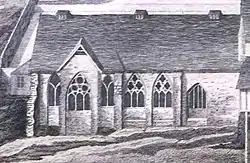
Kirby shows the refectory to have had tracery windows in the Decorated Gothic style, progressing from a geometric form at the north end to more curvilinear forms to the south, suggesting a sequence of construction from the late 13th to early 14th century. The final window has perpendicular mullions (a later style). The gable extension at the second window contained the raised lectern from which homilies or scriptures were read at mealtimes and (as Kirby's Plan shows) was approached externally by steps on the south side. The windows are raised to be set above the level of the seated diners. The upper end of this hall was to the north, and the later window and final bay probably mark the position of the screens passage at the lower end giving access to the buttery or pantry.[53] This building was used as a schoolroom until demolished in 1763, when the school moved into the old dormitory.[54] The windows either side of the chapter house doorway were also in curvilinear style.
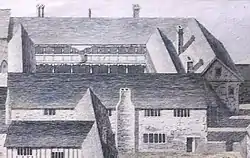
Although excavation revealed little of the more southerly part of the complex, the realization that the friary layout had conformed to an orderly plan, with a very imposing church, encouraged what was necessarily a more speculative interpretation of that part of Kirby's Prospect and Plan. Gilyard-Beer suggested that the two-tiered gallery courtyard then in use as Christ's Hospital, evidently of later construction,[55] had been rebuilt on the plan of an original second cloister which may also have been of two storeys. A large two-storied stone building possibly corresponding to that on the south side of the second cloister was still standing in 1845 and may have been the Infirmary. The buildings at the south-west corner perhaps occupied the site of the former prior's lodge and guest quarters.[56]
Suppression
The very copious bequests made to the friars of East Anglia show that the mendicants, who depended upon charitable donations for subsistence, were substantially favoured by the population they served throughout the 15th and early 16th centuries. Many requested burial at the Blackfriars.[57] Yet they became extremely impoverished. The Greyfriars closed first, where on 7 April 1538 the Visitor for the friaries, Richard Yngworth, Bishop of Dover, prepared an inventory and recovered certain church valuables which had been sold.[58] These he caused to be "leyd in a close house w[ithi]n the blak friers, suarly lokyd, and the p[ri]or chargyd with it".[59]
But even before this, in 1536 and 1537, the Black friars themselves were leasing out whatever properties were not immediately in use, including two gardens to Henry Tooley abutting on the garden of William Sabyn, a mansion and garden to Sir John Willoughby, various houses including "Lady Daundey's Lodging" to William Golding, and two dwellings (Friar Woodcoke's lodging, and another) to William Lawrence. They also leased out "a building called le Frayter, with upper chamber, and free ingress and egress", to Golding and Lawrence.[60] The original Frater (refectory) did not have an upper chamber. If "le Frayter" indicates the original dormitory building, that may be the origin of its later identification as a refectory.
In November 1538 Bishop Yngworth returned and the closure of the Whitefriars and Blackfriars followed. The conventual buildings were at first leased to William Sabyn,[61] King's serjeant-at-arms in Ipswich, whose land adjoined the friars' premises, and who is listed with the others in the minister's accounts of the Blackfriars rental. The entire property was sold to him in November 1541 to hold in chief for the twentieth part of a knight's fee, and a yearly tithe of five shillings. Sabyn was a considerable figure,[62] a naval sea-captain and veteran of numerous engagements, controller of the Ipswich customs (in succession to Sir Edward Echyngham) in 1527,[63] Bailiff, Portman and M.P., and a benefactor of St Mary-at-Key.[64] He soon afterwards died, his will being proved in 1543.[65] By intermediate means it became the property of the Borough of Ipswich. The subsequent uses of the site and buildings have their own stories.
References
- ↑ 'Dominican friaries: Ipswich', in W. Page (ed.), A History of the County of Suffolk, Vol. 2 (VCH, London 1975), pp. 122-23 (British History Online, accessed 8 May 2018).
- ↑ J. Kirby, 'The West View of Christ's Hospital in Ipswich' (engraved by J. Wood, 1748); J. Kirby, An Historical Account of the Twelve Prints of Monasteries, Castles, Ancient Churches and Monuments drawn by Joshua Kirby (Ipswich 1748, octavo).
- ↑ R. Gilyard-Beer, 'Ipswich Blackfriars', Proceedings of the Suffolk Institute of Archaeology and History XXXIV Part 1 (1977), pp. 15-23 (Suffolk Institute pdf). For Kirby's ground-plan of the site, see Gilyard-Beer p. 16.
- ↑ N.F. Layard, 'Underground Ipswich', East Anglian Daily Times, 28 September 1898; N.F. Layard, 'Original researches on the sites of religious houses of Ipswich: with plan of excavation', Archaeological Journal LVI (1899), p.232-8 (archaeology data service), at pp. 237-38.
- ↑ J. Blatchly and K. Wade, 'Excavations at Ipswich Blackfriars in 1897 and 1976', Proceedings of the Suffolk Institute of Archaeology and History XXXIV Part 1 (1977), pp. 25-34 (Suffolk Institute pdf).
- ↑ Historic England. "IPSWICH BLACKFRIARS (388250)". Research records (formerly PastScape). Retrieved 10 October 2015.
- ↑ Ipswich Archaeological Trust News, 7 (1984); 16 (1986).
- ↑ C.F.R. Palmer, 'The Friar-Preachers, or Blackfriars, of Ipswich', The Reliquary and Illustrated Archaeologist, New Series I for 1887 (1888), pp. 70-78 (Internet archive).
- ↑ Close Rolls, Henry III: A.D. 1261–1264 (HMSO, London 1936), p. 264 (Hathi Trust).
- ↑ Calendar of Patent Rolls, Henry III, A.D. 1258–1266 (HMSO, London 1910), p. 514 (Hathi Trust).
- ↑ W. Rye, A Calendar of the Feet of Fines for Suffolk (Suffolk Institute of Archaeology, Ipswich 1900), 53 Henry III, no. 16, p. 66 (Internet archive). View original at AALT.
- ↑ T.H. Turner (ed.), Manners and Household Expenses of England in the Thirteenth and Fifteenth Centuries, Illustrated by Original Records (William Nicol/Shakspeare Press, London 1841), p. 103 (Internet archive). See also pp. lxxvi-vii, note.
- ↑ Palmer, 'The Friar-Preachers, or Blackfriars, of Ipswich', at p. 72, with citations.
- ↑ J. Speed, 'A Catalogue of the Religious Houses Within the Realme of England and Wales', in The Historie of Great Britain Under the Conquests of the Romans, Saxons Danes and Normans (Iohn Sudbury & George Humble, cum Privilegio, London 1614), Book 9, Chapter 21, pp. 787-800, p. 797 (Google). His second edition (1623) made the friars preachers to be Austin Friars (Augustinians).
- ↑ J. Weever, Ancient Fvnerall Monvments Within The Vnited Monarchie Of Great Britain (Thomas Harper for Laurence Sadler, London 1631), pp. 750-52 (Google).
- ↑ W. Dugdale, Monasticon Anglicanum: Revised, English edition Vol. 6 Part III (James Bohn, London 1846), p. 1493 & notes (Google).
- ↑ 'Playz', in Dugdale, Baronage of England, II, p. 9 (Umich/eebo).
- ↑ 'Houses of Austin canons: The priory of Bromehill', in W. Page (ed.), A History of the County of Norfolk, Vol. 2, ed. William Page (V.C.H., London 1906), pp. 374-75 (British History online, accessed 11 May 2018).
- ↑ F. Blomefield, An Essay towards a Topographical History of the County of Norfolk (William Miller, London 1805), II, pp. 159-73 (Internet archive).
- ↑ G. Brenan and E.P. Statham, The House of Howard, 2 vols (Hutchinson & Co., London 1907), II, Table facing p. 32 (Internet archive).
- ↑ R. Taylor, Index Monasticus (Lackington & Co./J. & A. Arch/Rodwell & Martin, London 1821), p. 103 (Google).
- ↑ S. Alsford, 1998–2003, The Men Behind the Masque: Office-holding in East Anglian boroughs, 1272–1460, Ch. 3: The Monopolisation of Office, at note 67 and sources cited (The Orb – Online Reference Book for Medieval Studies).
- ↑ W.A. Copinger (ed.), County of Suffolk: Its History as Disclosed by Existing Records and Other Documents, Vol. I (Henry Sotheran & Co., London 1904), p. 279.
- ↑ V.B. Redstone, 'Calendar of Pre-Reformation Wills, Testaments, Probates, Administrations, registered at... Bury St Edmunds', Proceedings of the Suffolk Institute of Archaeology and Natural History XII Part 3 (1906), p. 3 (Suffolk Institute pdf p. 13).
- ↑ Calendar of Close Rolls, Richard II, Vol. I: A.D. 1377–1381 (HMSO, London 1914), pp. 31, 308 (Internet archive).
- ↑ For burials excavated at the site, see S. Mays, 1991, The Medieval Burials from Blackfriars Friary, School Street, Ipswich, Suffolk. English Heritage: Ancient Monuments Laboratory Unpublished Report, No. 16/91. Also S. Mays, The Archaeology of Human Bones (Routledge, 2010), pp. 29-31 & 244-45. Also S. Mays & G. Turner-Walker, 'A medieval case of Paget's disease of bone with complications', Journal of Paleopathology 11 Part 1 (1999), pp. 29-40.
- ↑ Calendar of Patent Rolls, Edward III: A.D. 1327–1330 (HMSO, London 1891), p. 74 (Internet archive).
- ↑ S.A. Mays, 'Healed limb amputations in human osteoarchaeology and their causes: A case study from Ipswich, UK', International Journal of Osteoarchaeology Vol. 6 issue 1 (January 1996), pp. 101-13.
- ↑ W.A. Copinger, The Manors of Suffolk: Notes on their History and Devolution Vol. 6: The Hundreds of Samford, Stow and Thedwestry (Author/Taylor, Garnett, Evans & Co. Ltd., Manchester 1910), p. 104.
- ↑ W.A. Copinger, The Manors of Suffolk: Notes on their History and Devolution Vol. 5: The Hundreds of Lothingland and Mutford, Plomesgate and Risbridge (Author/Taylor, Garnet, Evans and Co. Ltd., Manchester 1909), p. 12 and p. 64 (Internet archive).
- ↑ Palmer, 'The Friar-Preachers, or Blackfriars, of Ipswich', p. 76.
- ↑ K. Wade, 'Gipeswic – East Anglia's first economic capital, 600–1066', in N. Salmon and R. Malster (eds), Ipswich From The First To The Third Millennium (Ipswich, 2001), pp. 1–6.
- ↑ Palmer, 'The Friar-Preachers, or Blackfriars, of Ipswich', at p. 72.
- ↑ 'The Domus Day of Gippeswiche', in T. Twiss (ed.), Monumenta Juridica : The Black Book of the Admiralty : with an appendix, Vol. II: Appendix – Part II (Longman & Co./Trübner & Co., London 1873, pp. 15-207, at p. 18 (Internet archive).
- ↑ W.H. Richardson (ed.), The Annalls of Ipswche. The Lawes Customes and Governmt of the same.. by Nathanll Bacon (S.H. Cowell for Subscribers, Ipswich 1884) pp. 16-18, & 48 (Internet archive).
- ↑ 'Tibetot', in Dugdale, The Baronage of England, 2 vols (Tho. Newcomb, for Abel Roper, Iohn Martin, and Henry Herringman, London 1676), II, pp. 38-39 (Umich/eebo).
- ↑ 'Grey friars of Ipswich', in W. Page (ed.), A History of the County of Suffolk Volume 2 (VCH, London 1975), pp. 126-27 (British History Online, accessed 2 May 2018).
- ↑ Palmer, 'The Friar-Preachers, or Blackfriars, of Ipswich', at p. 70, with citations.
- ↑ T. Madox, Firma Burgi: or An Historical Essay Concerning the Cities, Towns and Buroughs of England (William Bowyer for Robert Gosling, London 1726), pp. 255-56 and notes (a) – (c) (Google). The National Archives, Inquisitions ad quod damnum, C 143/67/4.
- ↑ Calendar of Patent Rolls, Edward III, A.D. 1345–1348 (HMSO, London 1903), p. 91 (Hathi Trust). Palmer, 'The Friar-Preachers, or Blackfriars, of Ipswich', at p. 71.
- ↑ Bacon, Annalls of Ipswche, p. 57 (Internet archive).
- ↑ Palmer, 'The Friar-Preachers, or Blackfriars, of Ipswich', pp. 70-72.
- ↑ Similar descriptions are repeated by J. Wodderspoon, Memorials of the Ancient Town of Ipswich (Longman, Brown, Green and Longmans, London 1850), 305-13, at p. 307, by Palmer, 'The Friar-Preachers, or Blackfriars, of Ipswich', pp. 77-78 and by J. Glyde, 'The Black Friars and their monastery', in Illustrations of Old Ipswich, with architectural description... (John Glyde, Ipswich 1889), pp. 59-66 & Pl. (Internet archive)
- ↑ Gilyard-Beer, 'Ipswich Blackfriars', pp. 15-18.
- ↑ Gilyard-Beer, 'Ipswich Blackfriars', pp. 15-19.
- ↑ G.R. Clark, The History and Description of the Town and Borough of Ipswich (Stephen Piper, Ipswich 1830), p. 281, & Fig. after Jabez Hare following p. 288 (Hathi Trust).
- ↑ See, e.g., The British Museum, Collection ref. 1871, 0812.2974 (The British Museum, online collection). Description follows the old 'Refectory' attribution.
- ↑ Gilyard-Beer, 'Ipswich Blackfriars', p. 19.
- ↑ Other interior views were made by the Ipswich artist Walter Hagreen, who for some time had a studio in this building.
- ↑ Blatchly and Wade, 'Excavations at Ipswich Blackfriars', Fig. 9, p. 29, and p. 31.
- ↑ Calendar of Patent Rolls, Edward I: A.D. 1272–1281 (HMSO London 1901), p. 118 (Internet archive).
- ↑ Gilyard-Beer, 'Ipswich Blackfriars', pp. 19-20.
- ↑ Gilyard-Beer, 'Ipswich Blackfriars', p. 18.
- ↑ Blatchly and Wade, 'Excavations at Ipswich Blackfriars', p. 25.
- ↑ One part of the galleried buildings was illustrated by Henry Davy in 1845, see The British Museum, Collection ref. 1871. 0812.2975 (The British Museum, Online collection).
- ↑ Gilyard-Beer, 'Ipswich Blackfriars', pp. 20-22.
- ↑ Many such bequests are listed in Palmer, 'The Friar-Preachers, or Blackfriars, of Ipswich', pp. 72-75 (Internet archive).
- ↑ (Item 699) : 'Henry VIII: April 1538, 6-10', in J. Gairdner (ed.), Letters and Papers, Foreign and Domestic, Henry VIII, Vol. 13 Part 1, January–July 1538 (HMSO, London 1892), pp. 260-76 (British History Online, accessed 4 May 2018).
- ↑ Palmer, 'The Friar-Preachers, or Blackfriars, of Ipswich', pp. 76.
- ↑ Palmer, 'The Friar-Preachers, or Blackfriars, of Ipswich', pp. 76-77.
- ↑ He is mis-called William "Aubyn" in W. Page (ed.), A History of the County of Suffolk, Vol. 2 (William Constable, London 1907), p. 123, an error repeated by some careless authors. Early sources are unanimous for "Sabyn".
- ↑ J. Pound, 'Sabine, William (by 1491–1543), of Ipswich, Suff.', in S.T. Bindoff (ed.), The History of Parliament: the House of Commons 1509–1558 (from Boydell & Brewer, 1982), History of Parliament online.
- ↑ S.J. Gunn, Charles Brandon, Duke of Suffolk c. 1484–1545 (Oxford 1988), p. 99.
- ↑ Bacon, Annalls of Ipswche, pp. 212-13 (note b) (Internet archive). J. G. Webb, 'William Sabyn of Ipswich: an early Tudor Sea-officer and Merchant', The Mariner's Mirror 41 (1955), issue 3, pp. 209-221 (Taylor & Francis online).
- ↑ 'The will of William Sabyn, Sergeant at the Arms of Ipswich, Suffolk', P.C.C. 1543 (Spert quire). Inquisitions post mortem: The National Archives, C 142/68/2; WARD 7/1/63; E 150/643/44.
.jpg.webp)